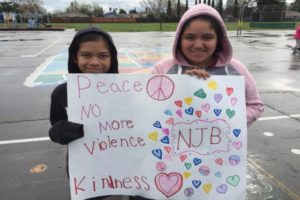Mitchell Elementary School Principal Stephanie Andrewlevich is betting on her students, and if she wins, she could be out $3,300.


Mitchell Elementary School Principal Stephanie Andrewlevich is betting on her students, and if she wins, she could be out $3,300.
Mitchell is located in one of Philadelphia’s poorest and most violent neighborhoods, and school officials have struggled to address rampant fighting and dismal academics for years. Just halfway into the 2015–16 school year, nearly a quarter of the school’s 8th-graders had been suspended, according to The Philadelphia Inquirer.
But there’s a different dynamic this year, and it started with a challenge Andrewlevich issued to 33 8th-graders: If all make it through the school year without a physical altercation, she’ll pay each student $100. The principal is shopping for sponsors for the initiative, but told The Inquirer she’s prepared to cover the cost out of her own pocket, if need be.
Earlier this month, students hit a milestone—70 days of peace—and it’s creating a more tranquil school culture that’s trickling down to lower grades, Andrewlevich said.
“I wanted to challenge them to be what their families see in them, what we know they are,” the principal said. “They have a choice—to become the violence they see in their day-to-day lives, or to be peaceful models for our school and our community.”
At first, students were motivated by the money—“they’d tell each other, ‘Don’t mess up my $100,’” Andrewlevich said—but the initiative eventually evolved into something bigger.
The Inquirer reports:
There are daily reminders: It’s day 50! It’s day 63! There’s a buzz in the building, a movement. Eighth graders conduct peer-mediation sessions with younger students, and the school will soon open its “Peaceful Place,” a room for students to cool down and practice conflict-resolution techniques.
Violence is down, school-wide, but the eighth graders especially have shown remarkable progress. In Andrewlevich’s first year at the school, students ended up at the police station for mediation multiple times, she said. So far this year, only 8 percent of the eighth-graders have been suspended. That’s down from 17 percent at the same point last year and 21 percent in 2016.
Student Zakaiya Barnes-Wiggins said last school year she “was always trying to fight somebody,” but things have changed. “ . . . Now, I don’t use my hands. I talk about it,” she said. “And it’s way better this way—our teachers can teach more.” Students haven’t forgotten about the cash prize, “but mostly, we just don’t want to fight anymore,” Barnes-Wiggins said.
Andrewlevich is leading a change in what the Institute of Advanced Studies in Culture’s James Davison Hunter and Ryan S. Olson describe as the “moral ecology” of a school.
In The Content of Their Character, a summary of research into character formation in a wide variety of schools, editors Hunter and Olson write that “Schools constitute their own moral ecosystems and are sites that advance their own particular views about human life and the just society.”
Hunter and Olson point out that, “Character is invariably formed in these moral ecologies and is reflective of them.”
While some fault Andrewlevich for “bribing” students to behave, the principal sees it a different way. She believes that these students can be peaceful—not only refraining from fighting, but mediating the conflicts of others. She believes it so strongly she put her own money on the line.
Now students are beginning to believe it, too.
Society “thinks of us as fighters, people who can’t control themselves,” 8th-grader Victoria Smith told The Inquirer. “But we’re different from that. I believe in my classmates—this is making us better.”
Building a culture where reconciliation rather than violence is normal takes hard work. The International Institute for Restorative Practices offers resources for teachers and administrators to “build social capital and achieve social discipline through participatory learning and decision making.”
For further reading on CultureFeed